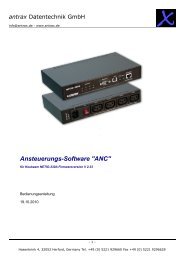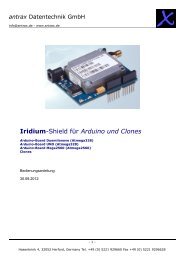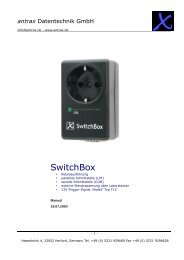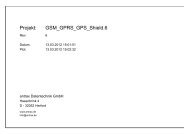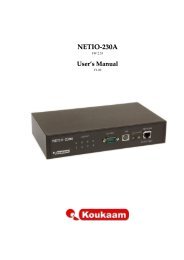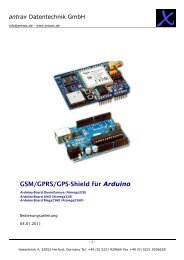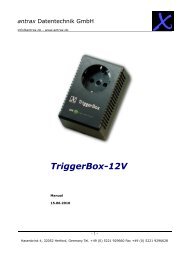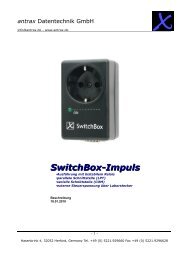Iridium Short Burst Data Service Developers ... - Discoverytelecom.eu
Iridium Short Burst Data Service Developers ... - Discoverytelecom.eu
Iridium Short Burst Data Service Developers ... - Discoverytelecom.eu
You also want an ePaper? Increase the reach of your titles
YUMPU automatically turns print PDFs into web optimized ePapers that Google loves.
<strong>Iridium</strong> Satellite LLC<br />
<strong>Short</strong> <strong>Burst</strong> <strong>Data</strong> <strong>Developers</strong> Guide V2.01<br />
5.3.2.1 Information Element Identifiers<br />
Each IE begins with a 1-byte information element identifier (IEI) that uniquely defines the following 2+N<br />
bytes. A complete list of the IEs and their associated IEIs is shown in Table 5-7.<br />
5.3.2.2 Information Element Length<br />
The two bytes following the IEI give the length of the IE in bytes following the initial three bytes. While the<br />
length for all currently defined IEs other than the MO and MT payloads may be represented with a 1-byte<br />
field, a 2-byte field is used for consistency across all IEs.<br />
The primary goal for including the length field in every IE as a standard is to allow for new IEs in the future<br />
that may or may not be recognized by a Vendor Application based the vendor’s upgrade path. If the<br />
application does not recognize an IE, it will know that it can read the next two bytes as a length and then<br />
skip that number of bytes before checking for the next IEI.<br />
5.3.2.3 Parsing Information Elements<br />
Once an entire message has been received, a parser will step through the bytes. The first will be an IEI<br />
followed by two bytes representing the number of bytes in the IE following the length. How to interpret these<br />
bytes is dictated by the IE type as indicated by the IEI. Once they are parsed, and if there are additional<br />
bytes received in the overall message, the next IEI may be checked, etc. If there are too many or too few<br />
bytes received as determined by the parser, the overall message will be dropped. For MT message<br />
processing, an error will be returned in the confirmation message.<br />
5.3.3 Successful MO Message Delivery Example<br />
Table 5-3 gives an example of a byte stream for a typical MO DirectIP message following a successful SBD<br />
session. Note that the IMEI has been provisioned such that the geo-location information is not included in<br />
the message.<br />
Table 5-3 MO DirectIP Message Delivery Example –Successful SBD Session<br />
Field Name <strong>Data</strong> Type Length (bytes) Value<br />
Protocol Revision Number char 1 1<br />
Overall Message Length unsigned short 2 104<br />
MO Header IEI char 1 0x01<br />
MO Header Length unsigned short 2 28<br />
CDR Reference (Auto ID) unsigned integer 4 1234567<br />
IMEI char 15 300034010123450<br />
Session Status unsigned char 1 0 (Transfer OK)<br />
MOMSN unsigned short 2 54321<br />
MTMSN unsigned short 2 12345<br />
Time of Session unsigned integer 4 1135950305 (12/30/05 13:45:05)<br />
MO Payload IEI char 1 0x02<br />
MO Payload Length unsigned short 2 70<br />
MO Payload char 70 Payload Bytes<br />
37<br />
<strong>Iridium</strong> Satellite LLC Proprietary & Confidential



